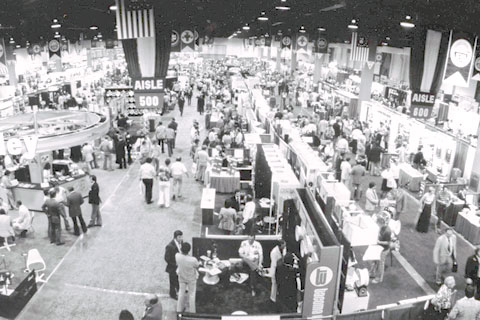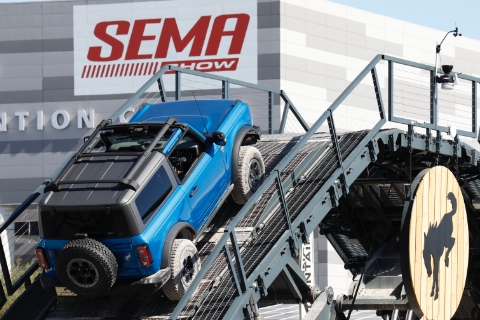SEMA News - July 2010
 |
|
He has been active in SEMA as well as in the Performance Warehouse Association (PWA) throughout most of his professional life and was elected to the SEMA Hall of Fame in 2006. Rollins was twice named the PWA Person of the Year and has served a total of 16 years on the SEMA Board of Directors. He recently took time to trade questions and answers with SEMA News, discussing his hopes and visions for the association. SEMA News: Thanks for taking the time to visit with us. Before we get to the business at hand, could you tell the SEMA members who may not know you a little bit about your background and how you got started in the industry?
Rick Rollins: Just a little bit? It’s been 40-some years, but I’ll try. Basically, I started working for an independent garage as a mechanic during and after high school. I also started racing during high school, driving go-karts on the International Kart Federation circuits for a couple of years. Wanting to learn a little more about the industry, I went to work as a counterman for an area jobber store, heading up its new high-performance division. From the contacts I made there, I went to work as the head high-performance buyer for what was at the time the largest high-performance warehouse in the country. I’ve also worked in sales for several different manufacturers, including Hastings Piston Rings, Taylor Cable Products and Superchips. During 14 years while I was working some of those jobs, I also traveled as a crewman on Top Fuel and Top Fuel Funny Car teams with World Champion Ray Motes. I later drove my own Formula Ford and Formula 2000 cars for about seven years. I’ve enjoyed the opportunities I’ve had to work in almost every entity of the industry, which always helped when I was trying to sell something because of the different experiences.
SN: As you progress through your first year as chairman, how has the experience compared to your expectations?
RR: First of all, I hope I’ve progressed. It has been an experience—and pretty much a fulltime one—but I’ve enjoyed it. I guess expectation-wise, it takes up more time than I expected—and I mean phone calls and e-mails on nights, weekends and so forth. I usually get the phone call as I sit down to dinner, and it goes something like this: “Are you at dinner? Well, this will only take a minute.” Then, an hour and a half later, I sit back down to my meal. But don’t get me wrong, it’s just doing what has to be done, when it has to be done. I don’t mind it at all.
SN: What are your top three priorities for the association?
RR: The first priority has been with the Board—trying to get the Board more detailed information, sooner, on some of the subjects it deals with so that the directors can make better decisions during meetings. If we can accomplish this, we will have a much better Board making more informed decisions, which will help the association overall. Next would be membership programs and services. Do the members know everything that the association has available for them? Are they the right programs and/or services? And are we, the association, making it the absolute best program or service that the members can get? We are really working this one hard; we just recently went through nearly all of our programs, looking at them from all angles and seeing what we can do better or maybe what we should drop or get out of. Third has been keeping up with legislation. That’s a fulltime job, but we have a great staff in Washington, D.C., and they do a great job of keeping their eye on the ball.
SN: It appears that the economy is beginning to recover. What is the outlook for the specialty-equipment market? How should companies adjust their expectations in the coming months?
RR: It’s showing signs of recovery, but I think it’s going to be slow. The good news is that our customer/consumer wants to buy our stuff. He’s been listening to bad news for too long, so as soon as he sees a little light at the end of the tunnel—even if it isn’t a bright light—he sees a chance to go buy something he’s been thinking about or looking at for the last year. I’m hearing that several companies, manufacturers, speed shops and distributors are seeing increases; the only problem is that they’re increases over last year. We need to see comparisons equal with 2007, and I don’t see that happening until 2011—hopefully. I do think that this is the right time to go after market share if you can afford to do it or can think far enough outside the box to get it.
SN: What do you think will be the most promising areas for growth in the automotive specialty-equipment market over the next few years?
RR: Oh thanks! If I knew that, I’d have to charge you for it! It is a good question, but it’s a tough one. It all depends on which consumers are still working or have the money to go spend. Is it the weekend racer or even the professional racer? Is it the off-roader who can finally spend the money for a lift kit? I would say that a product or service that works in all areas of the industry—racing, off-roading, for truck fans, for street rodders—if you had a product that was needed or worked on all of those vehicles or types of vehicles, then you might have something. It may even be something that fits with agriculture or work-truck applications. I can’t say exactly what it might be, but that’s what I’d look for.
SN: Where do the greatest challenges lie?
 |
|
|
Chairman Rick Rollins onstage with (from left) Immediate Past Chairman Jim Cozzie, Chairman-elect Scooter Brothers and past Chairs Mitch Williams and Corky Coker during the 2009 Installation Banquet & Gala Fundraiser. |
|
SN: The majority of specialty-equipment companies now have a substantial Internet presence. Do you foresee any changes in that sales environment?
RR: Only that it will get bigger. In this economy, it’s cheaper and easier to get to the consumer that way. Yes, our consumers still want to touch it and feel it, and there will still be a need for stores or shops, but maybe not on every corner. A good example is Bass Pro Shops or Cabela’s; these are both large mail-order/Internet companies that are adding retail locations for their customers to go to. A good businessman knows inventory, has the inventory, knows cash flow, and will still be here and needed. But outside of him, the Internet is going to fill the void in a more profitable manner.
SN: What is the one thing you would like SEMA members to understand and become more involved with, either in the industry generally or in the association itself?
RR: Learn everything you can from the whole industry. Get out of your shell. Get involved in anything you can. You might learn something. YEN does a great job of getting the young, energetic people fired up and involved, and our student programs are always turning out people who want to know more, want to be involved. I just think that, more times than not, some of us think we know it all, have it figured out and think our “involvement” is a waste of time. Well, people who think that way are wrong. Just look around. There has got to be something this industry or this association is doing that you could help with or learn from. Ask how.
SN: In addition to the issues you’ve touched on, are there other issues you have identified as being priorities for the association?
RR: We need to do a better job of getting our programs/services in front of the members. No, let me take that back. We need to do a better job of selling the programs/services to our members. We have found out that merely putting our programs out in front of the members doesn’t mean they see what’s available. It seems like every time I’m talking with someone and I say that SEMA does this or that, they come back with, “I didn’t know SEMA did that.” When you look, we’ve put information about SEMA’s programs and services in every possible place that it can be advertised or listed. We need to sell the programs. The good news is that we’ve recognized this and are putting a plan together to fix it.
SN: Is there anything else you would like to convey to the membership at this time?
RR: Well, this may not be the time nor the place, but I would like to thank everyone for the support given to my family after the recent loss of my oldest son, Richard. I really don’t know how I would have gotten through this time if it hadn’t been for this industry and the people in it. I will never be able to thank everyone the way I would like to, so this may have to do.








